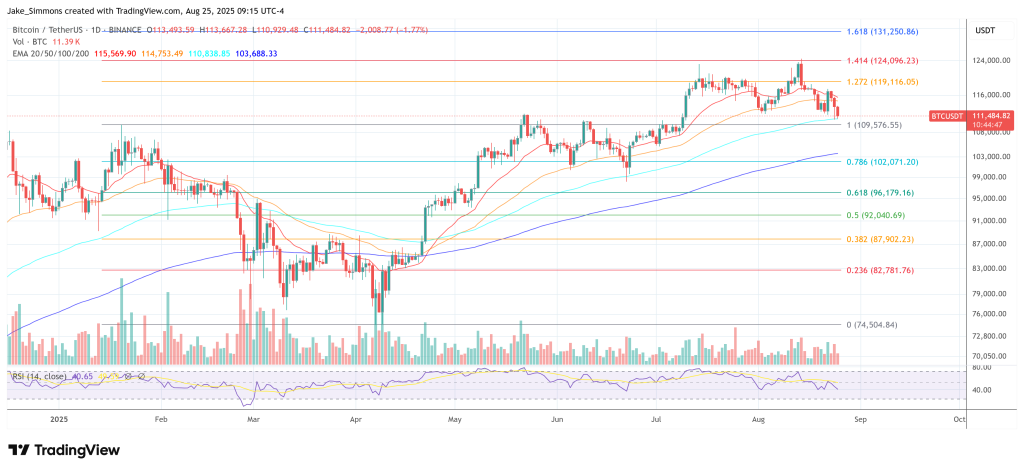Reasons to Trust

Robust editorial guidelines prioritizing accuracy, relevance, and neutrality
Developed by field specialists and thoroughly vetted
The highest standards in journalism and dissemination
Robust editorial guidelines prioritizing accuracy, relevance, and neutrality
Morbi pretium leo et nisl aliquam mollis. Quisque arcu lorem, ultricies quis pellentesque nec, ullamcorper eu odio.
In a recent episode of Coin Stories featuring host Nathalie Brunell, investor and podcaster Preston Pysh provided a well-founded response to a question many Bitcoin holders have been pondering this summer: why do prices keep fluctuating despite corporations announcing substantial purchases? Pysh attributes this to market dynamics created by sophisticated “fast-money” firms that operate to minimize volatility while capitalizing on basis and funding discounts.
Why Is Bitcoin Not Rising Much Higher?
Brunell candidly posed the question, pointing out the contradiction of spot Bitcoin remaining stagnant despite momentum from “the Trump administration” and numerous corporate treasury investments, along with inquiries into who is “really on the sell side” impeding aspirations for “$150k and $200k” year-end targets. Pysh expressed understanding of that dissonance: “I sense the frustration and the pain because it seems like every day brings more announcements of companies acquiring tens of thousands of bitcoins, yet the price declines.”
Related Reading: Bitcoin Holds Strong In ‘Wall Of Worry’, Path To $183,000 Remains Open – Analyst
He then highlighted the emergence of delta-neutral, volatility-harvesting strategies employed by prominent Wall Street trading firms. “If I were to hazard a guess, I’d say that fast money Wall Street traders—Jane Street being one example, among many—are in the business of extracting volatility from the market, engaging in long and short positions simultaneously without net exposure, and arbitraging the spreads.”
In practice, these trades combine spot, futures, and perpetual swaps, keeping the desk directionally neutral while capitalizing on spread differences. The subsequent effect, according to Pysh, is reflected on the charts: “As this occurs, the volatility will continue to diminish, even as prices rise… the volatility is becoming increasingly muted within this framework.”
This suppression alters the perception of an upward trend. Instead of the explosive price increases historically associated with Bitcoin bull markets, price movements consolidate into tighter ranges, marked by mean-reversion.
“Where I see this leading is to a scenario where the spring is tightening and will ultimately release in one direction or the other,” he noted. Although the long-term trend remains upward, he warned against the simplistic notion that a standard volatility squeeze will necessarily resolve in a sharp price increase. “Markets rely heavily on liquidity… They are influenced by many external factors… I’m not suggesting that collapsing volatility means we’re heading to… the moon.”
Related Reading
In Pysh’s view, liquidity is the key determinant in whether a coiled spring will ultimately release upwards. He analyzes global risk indicators as indicators of fiat liquidity, rather than focusing solely on cryptocurrency-specific flows.
“When reviewing liquidity metrics, I find that looking at global equity markets is particularly useful… If all global equity markets are performing well, it indicates that those markets are awash with liquidity—fiat liquidity. Right now, we’re witnessing a robust bidding environment. This is a positive sign for potential Bitcoin price increases, but it also hinges on the persistence of whatever is driving that liquidity.”
Feels like the most bearish bull market in Bitcoin.
What has been putting the sell pressure on btc? https://t.co/9EUuLJnerH pic.twitter.com/vPvpimm7rX
— Natalie Brunell ⚡️ (@natbrunell) August 23, 2025
Nonetheless, Pysh advised caution against interpreting volatility compression as a guaranteed lead-up to six-figure price points. “People must exercise caution… none of this ensures that prices will surge or that compression signals a leap to $200k in a matter of weeks.”
He acknowledged that if one adheres to the four-year halving cycle, this period appears distinct from past cycles. “We may have begun observing a change, which indicates a dampening of typical price actions… At this stage of the cycle, we would historically expect to see aggressive price movements underway and… truthfully, I would have predicted a different scenario by now,” he conceded, trailing off as if to acknowledge that the anticipated vertical growth has not unfolded as expected.
At the time of writing, BTC was valued at $111,484.

Featured image created with DALL.E, chart from TradingView.com

